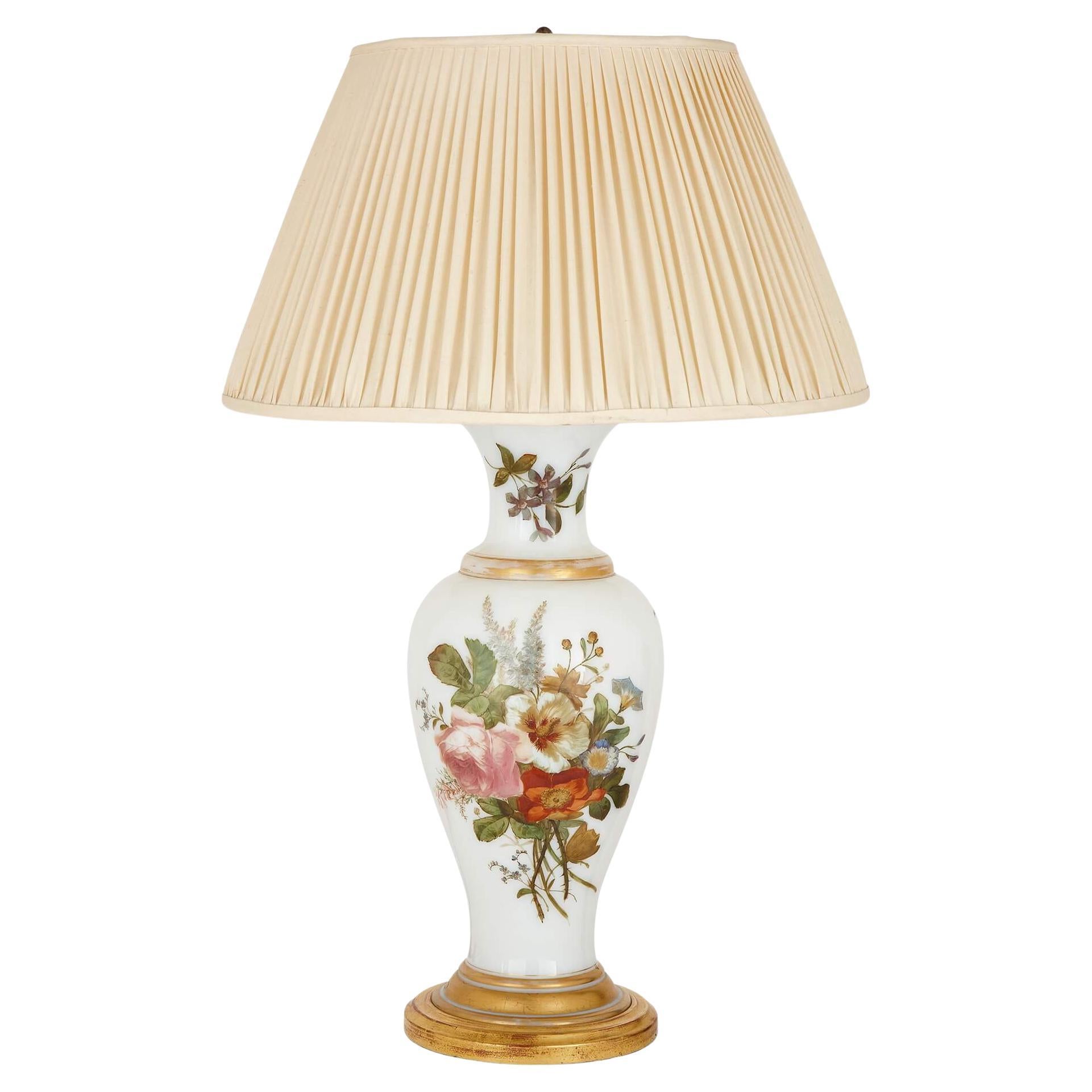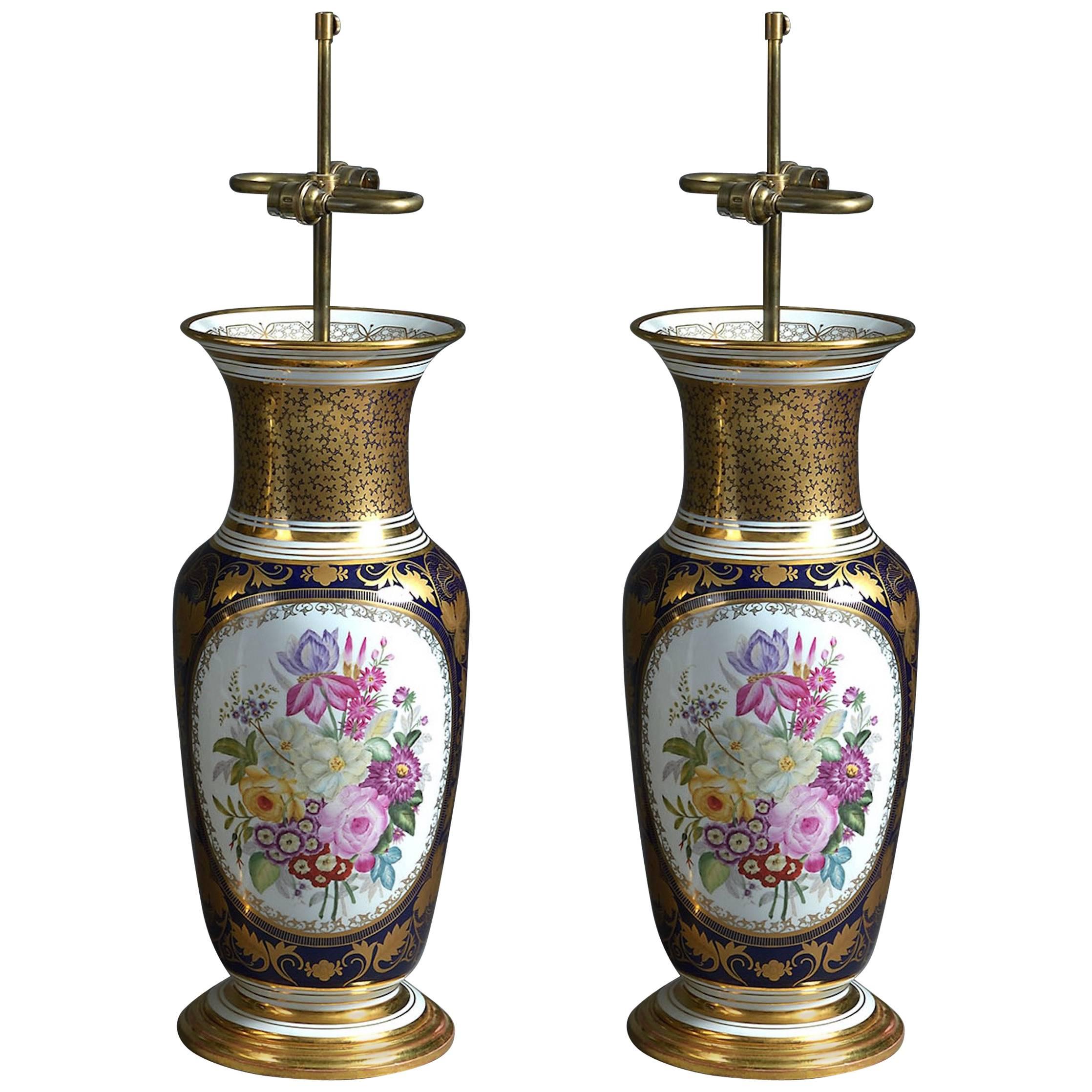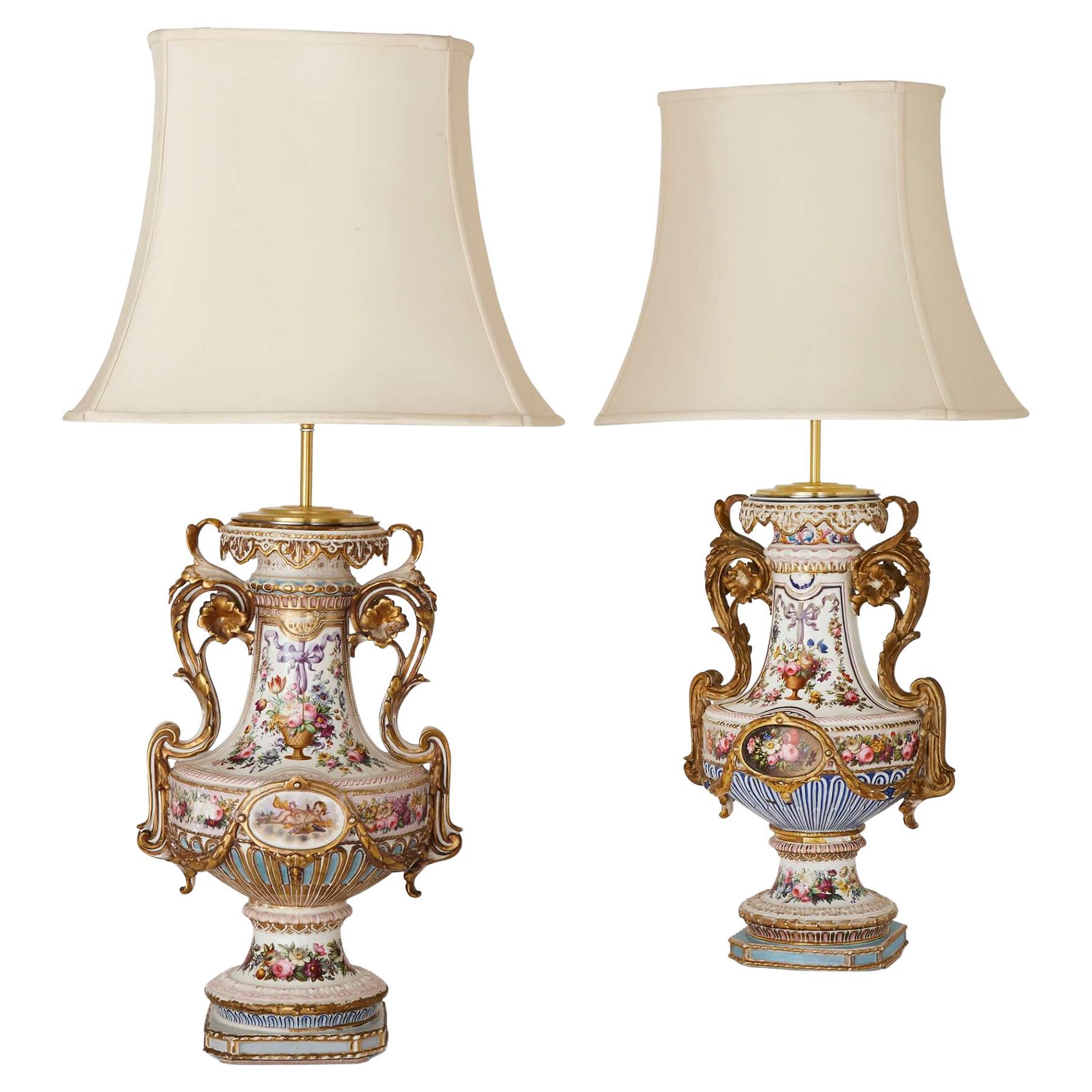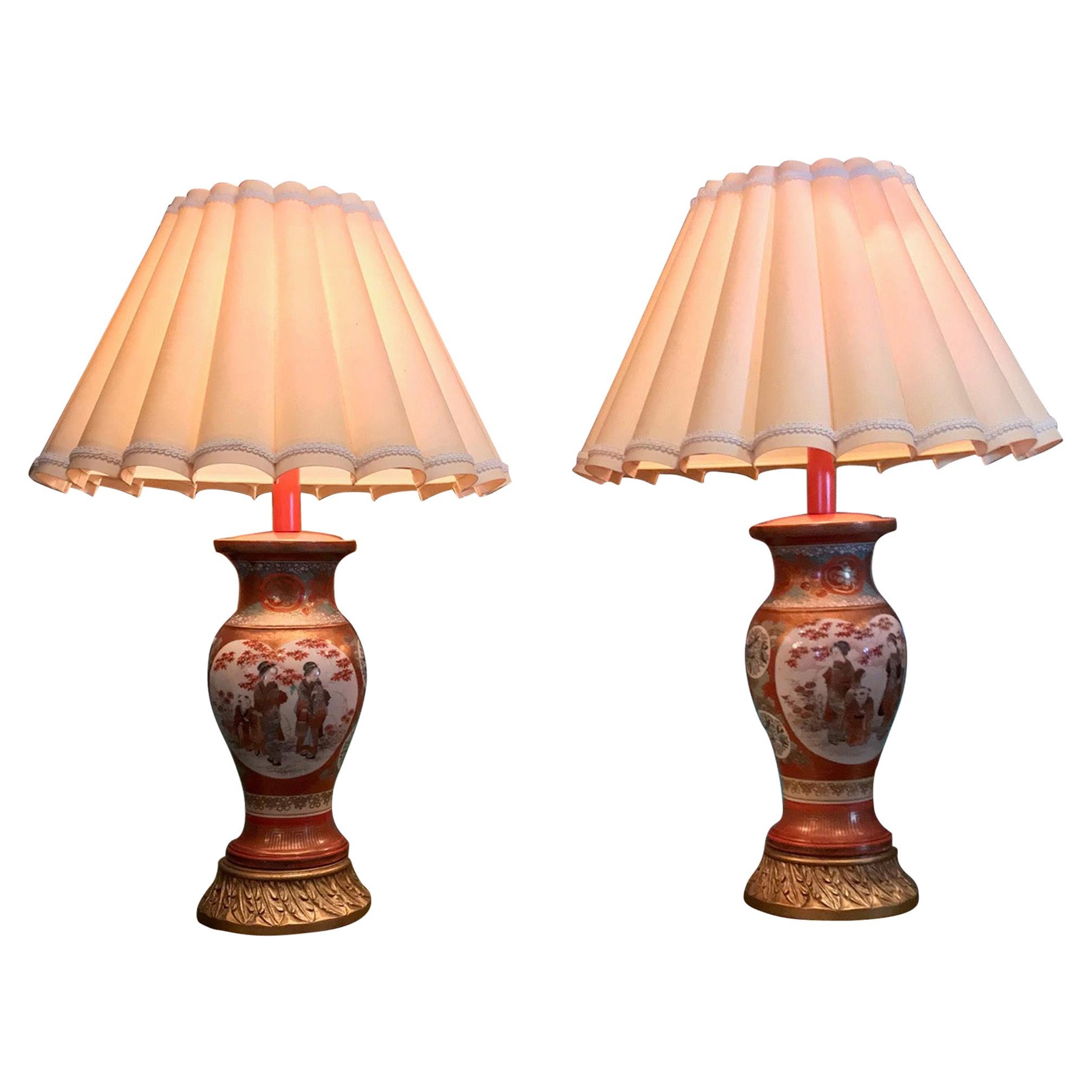Items Similar to Pair of Antique Porcelain Vase-Form Lamps with Floral Decoration
Want more images or videos?
Request additional images or videos from the seller
1 of 7
Pair of Antique Porcelain Vase-Form Lamps with Floral Decoration
About the Item
Pair of antique porcelain vase-form lamps with floral decoration
Continental, 19th Century
Lamps: height 57cm, width 18cm, depth 16cm
Shades: height 22cm, diameter 39cm
With twin handles and painted floral decoration, these fine porcelain lamps, originally porcelain vases, come with pleated shades, and are coloured with a celadon glaze above and below the central painted section. The painted elements are applied with fluid, light brushstrokes, and are near symmetrical in design across the two pieces, in complementary tones of greens, blues, pinks and lilacs.
Just below the ribbed handles on each side are a pair of grotesque bearded Classical masks, and a celadon glaze is applied to the neck and lower body of each piece. Adapted from vases, they make a beautiful pair of antique lighting instalments, (the height of each is 36.5cm, excluding lamp fittings.)
- Dimensions:Height: 22.45 in (57 cm)Diameter: 15.36 in (39 cm)
- Sold As:Set of 2
- Power Source:Plug-in
- Lampshade:Included
- Style:Rococo (In the Style Of)
- Materials and Techniques:
- Place of Origin:
- Period:
- Date of Manufacture:19th Century
- Condition:Wear consistent with age and use.
- Seller Location:London, GB
- Reference Number:
About the Seller
5.0
Recognized Seller
These prestigious sellers are industry leaders and represent the highest echelon for item quality and design.
Gold Seller
These expertly vetted sellers are highly rated and consistently exceed customer expectations.
Established in 1975
1stDibs seller since 2012
361 sales on 1stDibs
Typical response time: 5 hours
Associations
The British Antique Dealers' AssociationInternational Confederation of Art and Antique Dealers' Associations
- ShippingRetrieving quote...Ships From: London, United Kingdom
- Return PolicyA return for this item may be initiated within 14 days of delivery.
More From This SellerView All
- Baccarat Opaline Glass Lamp, Vase Formed with Floral DecorationBy BaccaratLocated in London, GBA Baccarat opaline glass lamp, vase formed with floral decoration French, 19th century Measures: Lamp: height 74cm, diameter 19cm Shade: heig...Category
Antique 19th Century French Rococo Table Lamps
MaterialsBrass
- Pair of Antique Florally Decorated Porcelain LampsBy Manufacture Nationale de SèvresLocated in London, GBPair of antique florally decorated porcelain lamps French, 19th century Measures: With shades: Height 101cm, width 49cm, depth 36cm Withou...Category
Antique 19th Century French Rococo Table Lamps
MaterialsPorcelain
- Pair of Large Pink-Ground Meissen Porcelain Floral VasesBy Meissen PorcelainLocated in London, GBPair of large pink-ground Meissen Porcelain floral vases German, Late 19th century Height 48, diameter 31cm Manufactured by the renowned German porcelain manufactory, this imp...Category
Antique Late 19th Century German Rococo Vases
MaterialsPorcelain
- Pair of antique Japanese porcelain vasesLocated in London, GBPair of antique Japanese porcelain vases Japanese, early 20th Century Height 86.5cm, diameter 36cm The beautiful Imari porcelain vases...Category
Early 20th Century Japanese Vases
MaterialsPorcelain
- Pair of Gilt Bronze Mounted Krater-Form Bisque Porcelain VasesLocated in London, GBPair of gilt bronze mounted krater-form bisque porcelain vases French, 19th century Measures: Height 43cm, diameter 26.5cm The pair of vases...Category
Antique 19th Century French Neoclassical Vases
MaterialsOrmolu, Bronze
- Antique pair of gilt bronze and Sèvres style porcelain cachepot vasesBy Manufacture Nationale de SèvresLocated in London, GBAntique pair of gilt bronze and Sèvres style porcelain cachepot vases French, 19th Century Height 24.5cm, width 17cm, depth 15cm...Category
Antique 19th Century French Rococo Planters, Cachepots and Jardinières
MaterialsOrmolu
You May Also Like
- Pair of Large Paris Porcelain Vases with Floral Panels Mounted as LampsLocated in London, GBAn exceptional pair of large scale Paris porcelain vases decorated with floral panels on one side and a stylised floral motif to the other side. Each body with gilded seaweed decorat...Category
Antique Early 19th Century French Table Lamps
MaterialsPorcelain
- Pair of Kutani Meiji Period Vases Porcelain Urns Table Lamps Antiques LA lightLocated in West Hollywood, CAA fine quality pair of Meiji period (1868-1912) Japanese Kutani porcelain vases made into lamps, 19TH century. Each with wonderful gold white and orange ground decoration. Inset painted panels depicting courtiers and a child, motifs and borders of exotic flowers. Antiques Dealer Los Angeles CA Beverly Hills. The table lamps emit very soft light, as delicate as the work and love invested in creating them. With handmade shades this pair of lights will add the perfect touch of elegance and refined taste to any room. From a boudoir to a bedroom, a powder room or a living room to an entryway. The perfect light for a side table, on an enfilade, a console or credence This exquisite pair of Mid Meiji period Japanese Kutani gilded hand painted porcelain vases has two panels in a heart shape depicting very finely painted clouds...Category
Antique Late 19th Century Japanese Meiji Table Lamps
MaterialsPorcelain
- Pair of French Ormolu-Mounted Blue-Ground Porcelain Vases Fitted as LampsLocated in New York, NYA fine quality pair of French Ormolu-Mounted Chinese Porcelain Vases mounted as lamps in mottled blue-ground glaze. Resting on square ormolu base with garland band and ormolu banded ...Category
Antique 19th Century French Chinoiserie Table Lamps
MaterialsBronze, Ormolu
- Massive Antique Vase Table Lamp with Hand Painted Floral DecorationLocated in London, GBAn impressive, very decorative porcelain vase, now mounted as table lamp, gilded and polychrome-decorated with flowers, on a water-gilded base, Continental, late 19th century. Hei...Category
Antique Late 19th Century German Beaux Arts Table Lamps
MaterialsGold
- Floral Porcelain Urn-Form LampLocated in New York, NYFloral porcelain urn-form lamp. Continental porcelain urn-form lamp with hand-painted flowers and gilt decorations on heavy gilt bronze base. Europe, ...Category
Antique 19th Century European Table Lamps
MaterialsPorcelain
- Pair of Porcelain Vases Ormolu-Mounted in Lamps by Gagneau Paris XIXth CenturyBy Gagneau ParisLocated in Saint-Ouen, FRPair of large Japanese Porcelain Cone Shape Vases with Imari decoration Important mounts in ormolu and gilded metal, the base decorated with a laurel wreath, the upper part of falling leaves and a frieze of knotted ribbon. The mounts signed Gagneau, 115 R. Lafayette. Circa 1860 With their original aluminium bulb cover and original gilding Vase it self Height 47 cm The Gagneau Company is one of the most famous lighting factories in Paris in the nine-teenth century, established in 1800 at 25 rue d'Enghien in Paris and later at 115 rue de Lafayette. She has participated in many exhibitions throughout this century. She began in 1819 with the Exposition des Produits de l'Industrie and later participated in the Universal Exhibitions where she was part of the jury in the category of art bronzes (class 25) at the Universal Exhibition in Paris in 1889. "Imari" was simply the trans-shipment port for Arita wares, from where they went to the for-eign trading outposts at Nagasaki. It was the kilns at Arita which formed the heart of the Japanese porcelain industry. Arita's kilns were set up in the 17th century, after kaolin was discovered in 1616. A popular legend attributes the discovery to an immigrant Korean potter, Yi Sam-Pyeong (1579–1655), although most historians consider this doubtful. After the discovery, some kilns began to produce revised Korean-style blue and white porcelains, known as Early Imari, or "Shoki-Imari". In the mid-17th century, there were also many Chinese refugees in northern Kyushu due to the turmoil in China, and it is said that one of them brought the overglaze enamel coloring technique to Arita. Thus Shoki-Imari developed into Ko-Kutani, Imari, and later Kakiemon, which are sometimes taken as a wider group of Imari wares. Ko-Kutani was produced around 1650 for both export and domestic market.Kutani Ware is characterized by vivid green, blue, purple, yellow and red colors in bold designs of landscapes and nature. Blue and white porcelain pieces continued to be produced and they are called Ai-Kutani. Ko-Kutani Imari for the export market usually adopted Chinese design structure such as kraak style, whereas Ai-Kutani for the domestic market were highly unique in design and are ac-cordingly valued very much among collectors. Ko-Kutani style evolved into Kakiemon-style Imari, which was produced for about 50 years around 1700. Kakiemon was characterized by crisp lines, and bright blue, red and green designs of dramatically stylized floral and bird scenes. Imari achieved its technical and aes-thetic peak in the Kakiemon style, and it dominated the European market. Blue and white Kakiemon is called Ai-Kakiemon. The Kakiemon style transformed into Kinrande in the 18th century, using underglaze blue and overglaze red and gold enamels, and later additional colors. Imari began to be exported to Europe when the Chinese kilns at Jingdezhen were damaged in the political chaos and the new Qing dynasty government halted trade in 1656–1684. Ex-ports to Europe were made through the Dutch East India Company, and in Europe the des-ignation "Imari porcelain" connotes Arita wares of mostly Kinrande Imari. Export of Imari to Europe stopped in mid-18th century when China resumed export to Eu-rope, since Imari was not able to compete against Chinese products due to high labor costs. By that time, however, both Imari and Kakiemon styles were already so popular among Eu-ropeans that the Chinese export porcelain copied both, a type known as Chinese Imari. At the same time, European kilns, such as Meissen and English potteries such as Johnson Bros. and (Royal) Crown Derby, also imitated the Imari and Kakiemon styles. Export of Imari surged again in late 19th century (Meiji era) when Japonism flourished in Europe.Thus, in the western world today, two kinds of true Japanese Imari can...Category
Antique 1880s French Japonisme Table Lamps
MaterialsBronze
Recently Viewed
View AllMore Ways To Browse
Antique Porcelains
Antique Table Decorations
Antique Floral Table
Table Floral Decorations
Fine Antique Table Lamps
Brass Antique Lamps Pair
Grotesque Furniture
Pair Of Antique Brass Lamps
Antique Pleater
Antique Grotesque
Grotesque Antique
Brass Floral Lamp
Brass Table Lamps Pair Antique
Pair Of Antique Brass Table Lamps
Antique Fluid
Painted Lamp Floral
Antique Floral Side Table
Pair 19th Century Brass Lamps





